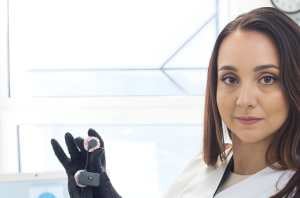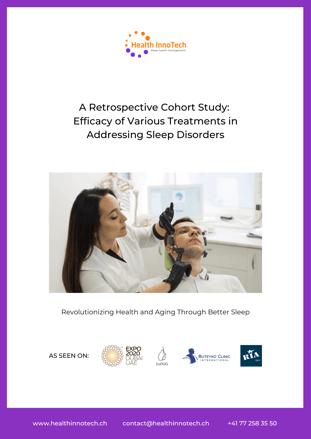Scientific Foundation


Olha Kozyk
Author of health-educational programs for wellbeing and longevity
Health-coaching specialist and biohacking expert
Winner of the 2018 Global Competition for Medical Scientific Papers for Myofunctional and Breathing Therapy methodology
Editorial and reviewer board member, International Journal of Scientific Research in Dental and Medical Science
Official representative, International Association of Facial Growth Guidance (UK)
Orthotropics trainer for over 400 doctors worldwide (https://orthotropics.com)
Honorary lecturer at over 60 training sessions for medical professionals and patients
Health InnoTech Cohort Study
This 10-year retrospective cohort study (n=744) compared CPAP, Myofunctional and Breathing Therapy, and the Healthy Sleep Program for treating sleep disorders. Results showed the 6-month Healthy Sleep Program was most effective across all severity levels, suggesting the efficacy of holistic, non-invasive approaches in sleep medicine.
Scientific Backing
Our solutions are grounded in over two decades of scientific research, ensuring that our methods are both effective and reliable. We collaborate with leading researchers and institutions to continually advance our understanding of sleep health.
MYOFUNCTIONAL AND BREATHING THERAPY: MUSCLE FUNCTIONING AND BREATHING. Olha Kozyk, Serhii Kozyk, Oleksandr Datsiuk, 1Smart Dental, Vinnytsia and Vinnytsia National Medical University, Ukraine. European Journal of Orthodontics, Volume 40, Issue 5, October 2018, Pages e1–e223, https://doi.org/10.1093/ejo/cjy060
Snoring Research
Poothrikovil RP, Al Abri MA. Snoring-induced nerve lesions in the upper airway. Sultan Qaboos Univ Med J. 2012 May;12(2):161-8. doi: 10.12816/0003108. Epub 2012 Apr 9. PMID: 22548134; PMCID: PMC3327562.
Read the article
OSA & Myofunctional Therapy
Camacho M, Certal V, Abdullatif J, Zaghi S, Ruoff CM, Capasso R, Kushida CA. Myofunctional Therapy to Treat Obstructive Sleep Apnea: A Systematic Review and Meta-analysis. Sleep. 2015 May 1;38(5):669-75. doi: 10.5665/sleep.4652. PMID: 25348130; PMCID: PMC4402674.
Read the article
de Felício CM, da Silva Dias FV, Trawitzki LVV. Obstructive sleep apnea: focus on myofunctional therapy. Nat Sci Sleep. 2018 Sep 6;10:271-286. doi: 10.2147/NSS.S141132. PMID: 30233265; PMCID: PMC6132228.
Read the article
Myofunctional Therapy and CPAP
Myofunctional therapy improves adherence to continuous positive airway pressure treatment
Read the article
ADHD/SBD/Myofunctional Therapy
Um YH, Hong SC, Jeong JH. Sleep Problems as Predictors in Attention-Deficit Hyperactivity Disorder: Causal Mechanisms, Consequences and Treatment. Clin Psychopharmacol Neurosci. 2017 Feb 28;15(1):9-18. doi: 10.9758/cpn.2017.15.1.9. PMID: 28138105; PMCID: PMC5290714.
Read the article
Mouth Breathing Research Articles
Lee SY, Guilleminault C, Chiu HY, Sullivan SS. Mouth breathing, “nasal disuse,” and pediatric sleep-disordered breathing. Sleep Breath. 2015 Apr 16;19(4):1257-64. In: PubMed Central [Internet]. Bethesda (MD): National Library of Medicine (US).
Read the article
The Mouth Breathing Syndrome: prevalence, causes, consequences and treatments. A Literature Review
Read the article
Intraoral pH and temperature during sleep with and without mouth breathing
Read the article
Hsu HY, Yamaguchi K. Decreased chewing activity during mouth breathing. J Oral Rehabil. 2012 Apr 10;39(8):559-67. In: PubMed Central [Internet]. Bethesda (MD): National Library of Medicine (US).
Read the article
Oral breathing and speech disorders in children
Read the article
Three-dimensional assessment of pharyngeal airway in nasal- and mouth-breathing children
Read the article
Myofunctional Therapy Research
Um YH, Hong SC, Jeong JH. Sleep Problems as Predictors in Attention-Deficit Hyperactivity Disorder: Causal Mechanisms, Consequences and Treatment. Clin Psychopharmacol Neurosci. 2017 Feb 28;15(1):9-18. doi: 10.9758/cpn.2017.15.1.9. PMID: 28138105; PMCID: PMC5290714.
Read the article
Daniela Galvão de Almeida Prado, Giédre Berretin-Felix, Renata Resina Migliorucci, Mariana da Rocha Salles Bueno, Raquel Rodrigues Rosa, Marcela Polizel, Isadora Ferraz Teixeira, Maria Beatriz Duarte Gavião. Effects of orofacial myofunctional therapy on masticatory function in individuals submitted to orthognathic surgery: a randomized trial. PMID: 29412368 PMCID: PMC5777416 DOI: 10.1590/1678-7757-2017-0164
Van Dyck C, Dekeyser A, Vantricht E, Manders E, Goeleven A, Fieuws S, Willems G. The effect of orofacial myofunctional treatment in children with anterior open bite and tongue dysfunction: a pilot study. Eur J Orthod. 2016 Jun;38(3):227-34. doi: 10.1093/ejo/cjv044. Epub 2015 Jul 1. PMID: 26136435; PMCID: PMC4914902.
Read the article
Yoon, A., Zaghi, S., Weitzman, R. et al. Toward a functional definition of ankyloglossia: validating current grading scales for lingual frenulum length and tongue mobility in 1052 subjects. Sleep Breath. 2017 Jan 17; 21(3): 767–775. In: PubMed Central [Internet]. Bethesda (MD): National Library of Medicine (US).
Read the article
Zaghi S, Valcu-Pinkerton S, Jabara M, et al. Lingual frenuloplasty with myofunctional therapy: Exploring safety and efficacy in 348 cases. Laryngoscope Investig Otolaryngol. 2019 Aug 26;4(5):489-496. In: PubMed Central [Internet]. Bethesda (MD): National Library of Medicine (US).
Read the article
Govardhan C, Murdock J, Norouz-Knutsen L, et al. Lingual and maxillary labial frenuloplasty with myofunctional therapy as a treatment for mouth breathing and snoring. Case Rep Otolaryngol.2019 Mar 10;([10 p.]. [about 5 screens]. [about 12 paragraphs]). In: PubMed Central [Internet]. Bethesda (MD): National Library of Medicine (US).
Read the article
Chuang LC, Lian YC, Auboiron MH, et al. Passive myofunctional therapy applied on children with obstructive sleep apnea: A 6 month follow up. J Formos Med Assoc. 2017 July 1;116(7):536-541. In ScienceDirect [Internet]. Amsterdam (NL): Elsevier.
Read the article
References
Respiratory Irregularity and Panic Disorders:
Abelson JL, Weg JG, Nesse R, Curtis M. (2001). “Persistent respiratory irregularity in patients with panic disorder.” Biological Psychiatry, 49: 588-595.
Sardinha A, Freire RC, Zin WA, Nardi AE. (2009). “Respiratory manifestations of panic disorder: causes, consequences and therapeutic implications.” J Bras Pneumol, 35(7):698-708.
Nardi AE, Freire RC, Zin WA. (2009). “Panic disorder and control of breathing.” Respir Physiol Neurobiol, 167(1):133-43.
Roth WT, Meuret A, Wilhelm F, Ritz T, Roth W. (2008). “Feedback of end-tidal pCO2 as a therapeutic approach for panic disorder.” J Psychiatr Res, 42(7):560-568.
Ley, Ley and Timmons, Brown and Gerbarg (1999). “Breathing Training: effect on anxiety and depression scores in behavioral breathlessness.” Journal of Psychosomatic Research, 38(1):11-21.
Nardi AE, Valença AM, Mezzasalma MA, et al. (2006). “35% Carbon dioxide and breath-holding challenge tests in panic disorder: a comparison with spontaneous panic attacks.” Depress Anxiety, 23(4):236-44.
Nardi AE, Valença AM, Mezzasalma MA, et al. (2006). “Comparison between hyperventilation and breath-holding in panic disorder: patients responsive and non-responsive to both tests.” Psychiatry Res, 142(2-3):201-8.
Breathing Techniques and Asthma:
Johnson BD, Scanlon PD, Beck KC. (1995). “Regulation of ventilatory capacity during exercise in asthmatics.” J Appl Physiol, 79(3):892-901.
Chalupa DC, Morrow PE, Oberdörster G, et al. (2004). “Ultrafine particle deposition in subjects with asthma.” Environmental Health Perspectives, 112(8):879-882.
Bowler SD, Green A, Mitchell CA. (1998). “Buteyko breathing techniques in asthma: a blinded randomized controlled trial.” Medical Journal of Australia, 169:575-578.
Hallani M, Wheatley JR, Amis TC. (2008). “Initiating oral breathing in response to nasal loading: asthmatics versus healthy subjects.” European Respiratory Journal, 31(4):800-6.
GINA. (2012). “Global Strategy for Asthma Management and Prevention.” GINA Report.
Breath-Holding and Dyspnea:
Nishino T. (2009). “Pathophysiology of dyspnea evaluated by breath-holding test: studies of furosemide treatment.” Respiratory Physiology Neurobiology, 167(1):20-5.
Barnai M, Laki I, Gyurkovits K, et al. (2005). “Relationship between breath-hold time and physical performance in patients with cystic fibrosis.” European Journal of Applied Physiology, 95(2-3):172-8.
Pérez-Padilla R, Cervantes D, Chapela R, et al. (1989). “Rating of breathlessness at rest during acute asthma: correlation with spirometry and usefulness of breath-holding time.” Rev Invest Clin, 41(3):209-13.
Nasal Breathing and Respiratory Health:
Djupesland PG, Chatkin JM, Qian W, et al. (2001). “Nitric oxide in the nasal airway: a new dimension in otorhinolaryngology.” Am J Otolaryngol, 22(1):19-32.
Shturman-Ellstein R, Zeballos RJ, Buckley JM, et al. (1978). “The beneficial effect of nasal breathing on exercise-induced bronchoconstriction.” American Review Respiratory Disease, 118(1):65-73.
Mangla PK, Menon MP. (1981). “Effect of nasal and oral breathing on exercise-induced asthma.” Clin Allergy, 11(5):433-9.
References on Myofunctional Therapy and Orofacial Disorders
Orofacial Myofunctional Therapy and Temporomandibular Disorders:
De Felicio CM, et al. (2010). “Effects of Orofacial Myofunctional Therapy on Temporomandibular Disorders.” JOURNAL OF CRANIOMANDIBULAR PRACTICE.
De Felicio CM, et al. (2012). “Validity of the 'protocol of oro-facial myofunctional evaluation with scores' for young and adult subjects.” Journal of Oral Rehabilitation, 39.
Swallowing and Respiratory Patterns:
Cedborg A, et al. (2014). “Co-ordination of spontaneous swallowing with respiratory airflow and diaphragmatic and abdominal muscle activity in healthy adult humans.” Experimental Physiology, 94(4):459-468.
Gurgor N, et al. (2013). “An electrophysiological study of the sequential water swallowing.” Journal of Electromyography and Kinesiology, 23.
Sleep Apnea and Myofunctional Therapy:
Guimarares K, et al. (2009). “Effects of Oropharyngeal Exercises on Patients with Moderate Obstructive Sleep Apnea Syndrome.” Am J Respir Crit Care Med, 179.
Huang Y, et al. (2013). “Pediatric obstructive sleep apnea and the critical role of oral-facial growth: evidences.” Frontiers in Neurology.
Guilleminault C, et al. (2012). “Teenage sleep-disordered breathing: Recurrence of syndrome.” Sleep Medicine, 14:37-44.
Oral Appliances Therapy
American Academy of Sleep Medicine. Oral Appliance Therapy for Obstructive Sleep Apnea: An Update of the Evidence. J Clin Sleep Med. 2020 Apr 15;16(4):659-666.
Chirinos JA, Gurubhagavatula I, Teff K, et al. CPAP, Weight Loss, or Both for Obstructive Sleep Apnea. N Engl J Med. 2014 May 22;370(24):2265-2275. doi: 10.1056/NEJMoa1306187. In: PubMed Central [Internet]. Bethesda (MD): National Library of Medicine (US).
Cartwright R, Ristanovic R, Diaz F, Caldarelli D, Alder G. A comparative study of treatments for positional sleep apnea. Sleep. 1991 Sep;14(4):346-50.
Liu Y, Su M, Sun H, Zhang S, Ao H, Cheng H. Effect of mandibular advancement device treatment on apnea-hypopnea index and minimum oxygen saturation in obstructive sleep apnea. Circ Cardiovasc Qual Outcomes. 2013 May 1;6(3):303-10. doi: 10.1161/CIRCOUTCOMES.113.000128.
Dieltjens M, Vroegop AV, Verbruggen AE, et al. A promising concept of combination therapy for positional obstructive sleep apnea. Sleep Breath. 2015 Sep;19(3):637-44. doi: 10.1007/s11325-014-1031-4. In: PubMed Central [Internet]. Bethesda (MD): National Library of Medicine (US).
Marklund M, Stenlund H, Franklin KA. Mandibular advancement devices in 630 men and women with obstructive sleep apnea and snoring: tolerability and predictors of treatment success. Chest. 2004 Dec;126(6):1731-8.
Vanderveken OM, Dieltjens M, Wouters K, et al. Objective measurement of compliance during oral appliance therapy for sleep-disordered breathing. Thorax. 2013 Mar;68(3):274-81. doi: 10.1136/thoraxjnl-2012-202071.
Ferguson KA, Ono T, Lowe AA, Keenan SP, Fleetham JA. A randomized crossover study of an oral appliance vs nasal-continuous positive airway pressure in the treatment of mild-moderate obstructive sleep apnea. Chest. 1996 Jun;109(6):1269-75.
Russo H, Avidan A, Ayalon L, et al. Oral appliance therapy versus nasal continuous positive airway pressure in obstructive sleep apnea: a randomized, placebo-controlled trial. Sleep Breath. 2013 Mar;17(1):221-9. doi: 10.1007/s11325-012-0686-4.
Chan AS, Sutherland K, Schwab RJ, Zeng B, Petocz P, Lee RW. The role of mandibular advancement devices in treating patients with obstructive sleep apnea hypopnea syndrome. Expert Rev Respir Med. 2017 Feb;11(2):89-99. doi: 10.1080/17476348.2017.1274418.
Kushida CA, Morgenthaler TI, Littner MR, et al. Practice parameters for the treatment of snoring and obstructive sleep apnea with oral appliances: an update for 2005. Sleep. 2006 Feb 1;29(2):240-3.
Sutherland K, Cistulli PA. Mandibular advancement splints for the treatment of sleep apnea syndrome. Swiss Med Wkly. 2011 Sep 26;141. doi: 10.4414/smw.2011.13276.
Hoekema A, Stegenga B, De Bont LG, Boering G. A randomized, controlled crossover study of oral appliance therapy in obstructive sleep apnea-hypopnea syndrome. Clin Respir J. 2013 Oct;7(4):382-7. doi: 10.1111/crj.12002.
Kamra K, Tewari A, Kohli M, et al. A 2-year assessment of uvulopalatopharyngoplasty and tongue base surgery for moderate to severe obstructive sleep apnea. Otolaryngol Head Neck Surg. 2010 Dec;143(6):978-84. doi: 10.1016/j.otohns.2010.08.021.
Aarab G, Lobbezoo F, Hamburger HL, Naeije M. Oral appliance therapy versus nasal continuous positive airway pressure in obstructive sleep apnea: a randomized, placebo-controlled trial. J Clin Sleep Med. 2011 Aug 15;7(4):380-5. doi: 10.5664/JCSM.1120.
Schwab RJ, Kim C, Bagchi S, et al. Understanding the anatomic basis for obstructive sleep apnea syndrome in adolescents. Am J Respir Crit Care Med. 2002 Nov 15;166(10):1298-305. doi: 10.1164/rccm.201212-2223OC.
Aboudara C, Nielsen I, Huang JC, Maki K, Miller AJ, Hatcher D. Comparison of airway space with conventional lateral headfilms and 3-dimensional reconstruction from cone-beam computed tomography. Am J Orthod Dentofacial Orthop. 2009 Oct;136(4):426-34. doi: 10.1016/j.ajodo.2008.08.022.


